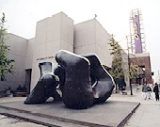| June
24-28, 2012 The 2012 Annual Meeting of the Canadian Applied and Industrial Mathematics Society |
 |
 |
 |
 |
 |
 |
|

| Math Biology and Medicine | |
|
|
|
|
Theme Organizers: Siv Sivaloganathan (Waterloo) and Pauline van den Driessche (UVic)
|
|
|
Speakers
in Infectious Diseases Theme
|
Speakers
in Cancer Modelling Theme
|
|
Julien
Arino (Manitoba) |
Helen
Byrne (Oxford) |
Mass gatherings are socially motivated occasional or periodic convergences of a large number of individuals to one location. Examples include sport events such as the Summer and Winter Olympic Games and the FIFA World Cup every four years, religious pilgrimages such as the Hajj every year and Kumbh Mela every six years, large music festivals, etc.The specific nature of each mass gathering varies. However, there are common characteristics, the most important of which being that they occur in three phases: convergence to the mass gathering site, actual event and return of individuals to their homes.I will present deterministic and stochastic metapopulation infectious disease models used to evaluate the consequences of the co-occurrence of a mass gathering and an infectious disease outbreak. This work in the context of the Bio.Diaspora Project is joint with my student Liliana Menjivar.
The emergence and spread of infections diseases is a problem of global interest with enormous human and economic consequences. Population and network disease models yield insight into, and guide policy aimed at mitigating, the spread of these public health threats. In such models, the central notion of contact greatly influences the disease epidemic outcomes, but its definition remains nebulous. We discuss how a combination of theoretical and experimental biofluid dynamics approaches can assist in revisiting the dynamics of contact and transmission of infectious diseases
A disease transmission model of SEIRS type with distributed delays in latent and temporary immune periods is presented. With general probability distributions in both of these periods, we address the threshold property of the reproductive number R0 and the dynamical properties of the disease-free/endemic equilibrium points present in the model. More specifically, we discuss the dependence of R0 on the probability distribution in the latent period and the independence of R0 from the distribution in the temporary immunity, and establsh conditions for the global asymptotical stability of the respective equilibria. Conditions for the existence of oscillatory solutions through Hopf bifurcations will also be given.
Vector-borne diseases are a typical infectious disease which can cause severe illness in humans or animals. Vectors like mosquitoes or ticks play a critical rule in the transmission and spread of the diseases. To investigate the role of vectors, we formulate a system of delay differential equations to model the transmission dynamics of the diseases between vectors and their hosts. Analytical analyses show that vectors alone can force the system to oscillate. The interaction between vector and amplification host is unlikely responsible for oscillatory behaviors of the system. Case studies for West Nile virus and malaria are presented.
We model larviciding of mosquitoes taking into account the evolution of resistance to the larvicides, the evolutionary costs of resistance and the implications for malaria control. There is evidence that resistance comes with various costs one of which is reduced adult longevity for resistant mutants. The mosquito adult lifespan is one of the most crucial parameters in malaria transmission due to a long developmental time for the malaria parasite in the insect. A possible malaria control strategy is therefore to shorten this adult lifespan by larviciding with a potent larvicide to which mosquitoes become resistant. This novel strategy is studied using a mathematical model for the wild type and resistant mutants and by incorporating the malaria disease dynamics using an SEI type model with standard incidence that incorporates the latency period of the parasite in wild type and resistant mosquitoes. We consider the linear stability of the malaria–free equilibrium in which the resistant strain is dominant and derive a condition for the global eradication of malaria. Numerical simulations are presented which offer further insights. The parameter to which the analysis is most sensitive is the per–capita death rate of adult resistant mosquitoes. Increasing this parameter dramatically reduces the basic reproduction number R0. However, increasing it too much causes the wild type to outcompete the resistant mutants and the control strategy fails. Exploitation of costs of resistance to larvicides thus offers a possible malaria control measure if the larvicide is sufficiently potent and costs of resistance are neither too great not too small.
In a hospital setting, certain pathogens are passed back and forth between health care workers (HCW) and patients. HCWs remain contaminated on a time-scale related to the length of a hospital shift. Patients remain infected on a time-scale related to the duration of their stay in the hospital. Often, these infections are drug-resistant and so their control is very important. Nevertheless, such infections remain common.We study a two group SIR model, with continuous age-structure in the infected classes. We allow that infectivity and recovery may depend on the age-of-infection. The resulting model is a PDE, which includes delay models and ODE models as special cases.We study the issue of persistence of the disease versus extinction, as well as global stability through the use of a Lyapunov functional.
Cholera is a bacterial disease that can be transmitted to humans directly by person-to-person contact or indirectly via the environment (mainly contaminated water). A multi-group cholera model is formulated that incorporates direct and indirect transmission with nonlinear incidence, as well as spatial or host heterogeneity. The basic reproduction number R0 is determined and shown to give a sharp threshold. If R0 = 1, then the disease-free equilibrium is globally asymptotically stable and cholera dies out from all groups; whereas if R0 > 1, then the unique endemic equilibrium is globally asymptotically stable and the disease persists at an endemic level in each group. The proof of global stability utilizes a graph-theoretic approach and a new combinatorial identity.
We present a new compartmental influenza model, designed to follow the dynamics of four influenza strains (two A, two B) within an age-stratified, evolving population over many years. Mixing among age groups is implemented via a contact matrix. Population birth and death rates can vary over time, as can vaccination strategies and vaccine efficacy. Cross-protection is modeled between the A strains, and between the B strains. We describe our solutions to some problems intrinsic to multi-strain compartmental models, and also discuss our approach to parameter fitting.
A mathematical model is derived to describe the transmission and spread of malaria over a patchy environment. The model incorporates two factors: disease latencies in both humans and mosquitoes, and dispersal of humans between patches. We derived the basic reproduction number R_0 for the structured disease model. The dynamics ofthe model is investigated in terms of R_0. It is shown that the disease dies out if R_0<1; and the disease is endemic if R_0>1. For the case of two patches, some more explicit conditions are obtained, and impacts of dispersal rates in all different compartments on R_0 are also explored. Some numerical simulations are performed which show that the impacts could be very complicated: in a certain range of the parameters, R_0 is increasing with respect to a dispersal rate while in another range, it can be decreasing with respect to the same dispersal rate.
This presentation attempts to synthesize stochastic and deterministic disease transmission models and to put them in a statistical context, such as parameter estimation and prediction. It starts with brief reviews of the univariate and bi-variate birth-death Markov processes used as SIS and SIR models (Allen, 2011, second edition) and compare them against their deterministic counterparts. In a finite population setting, the deterministic models can be regarded as ordinary differential equation models for the stochastic mean values of the birth-death processes under an extreme case of the moment closure framework by setting the second order moments to zero. Alternatively, the deterministic models are often regarded as approximations to the ODE models for the stochastic mean values as the population size approaches infinity. Therefore, the presentation proceeds with the discussions of the contexts under which the stochastic models do and do not “average out” to their deterministic counterparts, in infinitely large populations. These further lead to the statistical implication for estimating parameters in disease models, where data, even in the perfect suitable of continuous and complete observation, tend to arise from a single realization of the sample paths of an inherently stochastic event. The final part of the presentation will discuss the notion of “heterogeneity” in disease models and the proposal of formulating such a concept in terms of stochastic orders, along with some application results from recent publications in the study of the initial growth and evaluation of effectives of certain infectious disease control measures.
Speakers in Cancer Modelling Theme
----------
Helen Byrne (University of Oxford)
Multiscale modeling of the intestinal crypt and early colorectal
cancer
The luminal surface of the gut is lined with a monolayer of epithelial cells that acts as a nutrient absorptive engine and a protective barrier. To maintain its integrity and functionality, the epithelium is renewed every few days. A range of theoretical approaches has been proposed to model crypt homeostasis and neoplasia. For example, subcellular models of the Wnt signaling pathway can be coupled to models of the cell cycle in order to predict how changes in the extracellular Wnt stimulus affect a cell's ability to proliferate and how mutations in the Wnt signaling pathway lead to hyperproliferation. Equally, continuum models can provide a coarse-grained description of the spatio-temporal dynamics of entire crypts. Multiscale models occupy the middle ground, permitting a detailed description of the interplay between processes acting on the subcellular, cellular and tissue scales. In this talk, I will introduce a simple model of the Wnt signaling pathway and show how its integration within a cell-based model can provide new insight into the cellular dynamics of healthy and neoplastic crypts.
----------
Corina Drapaca (Penn State)
Mathematical Modeling of Tumors Classification
The US National Center for Health Statistics reported recently that cancer is about to become the deadliest disease of modern times. The advancements in medicine of the last decade have reduced considerably the death rates of serious diseases such as heart disease, stroke, and pneumonia, but unfortunately similar progress has not happen yet with cancer. Theoretical models capable of explaining the fundamental mechanisms of tumor growth and making reliable predictions are essential in the design of optimal, personalized therapies that will maximize treatment outcomes and reduce health care costs. In this talk we will present a mathematical model that is able to differentiate not only between healthy and pathologic tissues, but, more importantly, between benign and malignant tumors. Our multiscale triphasic model for biological tissues couples biochemical processes that take place in tissue's microstructure and tissue's mechanics and thus could explain for instance the role played by the stiffness of a tumor and its microenvironment in the transition from a low (benign) to a high (malignant) grade tumor. The multiscaling is based on a recently developed homogenization technique for materials with evolving microstructure.
Recent advances in virology, gene therapy and molecular and cell biology have provided insight into the mechanisms through which viruses can boost the anti-tumour immune response, or can infect and kill directly tumour cells. Here, we derive a mathematical model to investigate the anti-tumour effect of two viruses and their interactions with the immune cells. We then discuss the role of virus persistence on the elimination of tumour cells. To this end, we focus on multi-stability and multi-instability, two complex phenomena that can cause abrupt transitions between different states in biological and physical systems. In the context of cancer immunotherapies, the transitions between a tumour-free and a tumour-present state were so far associated with the multi-stability phenomenon. Here, we show that the multi-instability phenomenon can lead to the formation of a homoclinic bifurcation, which causes the system to switch from a tumour-present to a tumour-free state. This multi-instability phenomenon is driven by the persistence of the virus, while the multi-stability phenomenon is driven by the immune response.
Articular cartilage physiology is regulated by a single population of specialized cells called chondrocytes. The chondroyctes are sparsely distributed within an extracellular matrix (ECM), maintaining a state of homeostasis in healthy tissue. ECM degeneration due to osteoarthritis can lead to complete degradation of cartilage surfaces, necessitating total joint replacement. Chondrocytes can be utilized to regenerate cartilage ECM via tissue engineering approaches in which these cells are seeded in degradable biopolymer or hydrogel scaffolds. In such systems, biosynthetic activity of the cells in response to their non-native environment results in regeneration and accumulation of ECM constituents concurrent with degradation of the surrounding scaffold material. In this talk, mixture models are presented for interactions between biosynthesis of ECM constituents and ECM linking in cell-seeded scaffolds. Both ODE-based (temporal) models for evolution of average apparent densities and PDE-based (spatio-temporal) models will be presented for variables including unlinked ECM, linked ECM and scaffold. Of particular interest are model predictions influencing the compressive elastic modulus of the tissue construct. These models provide a quantitative framework for assessing and optimizing the design of cell-scaffold systems and guiding strategies for articular cartilage tissue engineering.
Mathematical models for the tumor control probability (TCP) are used to estimate the expected success of radiation treatment protocols of cancer. There are several mathematical models in the literature and we made the experience that simple and complex models often make the same predictions. Here we compare six of these TCP models: the Poisson TCP, the Zaider-Minerbo TCP, a Monte Carlo TCP, and their corresponding cell cycle (two-compartment) models. Several clinical non-uniform treatment protocols for prostate cancer are employed to evaluate these models. These include fractionated external beam radiotherapies, and high and low dose rate brachy therapies.We find that in realistic treatment scenarios, all one-compartment models and all two-compartment models give basically the same results. A difference occurs between one compartment and two compartment models due to reduced radiosensitivity of quiescent cells. Based on our results, we can recommend the use of the Poissonian TCP for every day treatment planning. More complicated models should only be used when absolutely necessary.
Recent studies have questioned the application of standard scaling analysis to study radially growing interfaces. We show that the radial Edwards-Wilkinson equation belongs to the same universality as that obtained in the planar geometry. In addition, we use numerical simulations to caculate the interface width for both random deposition with surface relaxation and restricted solid on solid models, assuming system size increases linearly with time(due to radial geometry). By applying appropriate roules for each model, we show that the interface width increases with time as t^, where the exponent is the same as those obtained from the corresponding planar geometries.
A mathematical model is presented for the concentrations of proangiogenic and antiangiogenic growth factors, and interstitial fluid pressure, in solids tumours embedded in host tissue. In addition to production, diffusion, and degradation of these angiogenic growth factors (AGFs), we include interstitial convection to study the locally destabilizing effects of interstitial fluid pressure (IFP) on the angiogenic activity endowed by these factors. The molecular sizes of representative AGFs and the outward flow of interstitial fluid in tumors suggest that convection can be a significant mode of transport for these molecules. The resulting balance or imbalance of proangiogenic and antiangiogenic factors serves as a possible mechanism for determining whether blood vessels are stable, developing or regressing. The results of our modeling approach suggest that changes in the physiological parameters that determine interstitial fluid pressure have as profound an impact on tumor angiogenesis as those parameters controlling production, diffusion, and degradation of AGFs. This model has predictive potential for determining the angiogenic behavior of solid tumors and the qualitative effects of cytotoxic and antiangiogenic therapies on tumor angiogenesis.
The therapeutic control of a solid tumour critically depends on the responses of the individual cells that constitute the entire tumour mass. From a modelling perspective, these biological cells can be considered as discrete entities. An individual cell’s spatial location within the tumour and its intracellular dynamics, including the evolution of the cell cycle within each cell, has an impact on the decision to grow and divide. There is also influence by signals from other neighbouring cells and the local oxygen and nutrient concentrations. Hence, it is important to take all of these “multi-scale” factors into account when modelling solid tumour growth and its response to various cell-kill therapies, including chemotherapy.
In order to address this multi-scale nature of tumour growth, we propose a hybrid, individual-based model that analyses the spatiotemporal dynamics at the level of cells, linking individual cell behaviour with the macroscopic behaviour of cell organisation and the microenvironment. The evolution of tumour cells is modelled by using a cellular automaton (CA) approach, where each cell has its own internal cell cycle, modelled using a system of ODEs. The internal cell cycle dynamics determine the growth strategy in the CA model, making it more predictive and biologically relevant. It also helps us to classify the cells according to their cell cycle states and to analyse the effect of various cell-cycle dependent cytotoxic drugs. Moreover, we have incorporated the evolution of oxygen dynamics within this hybrid model in order to study the effects of the microenvironment in cell-cycle regulation and tumour treatments. This is an important factor from a treatment point of view, as the low concentration of oxygen can result in a hypoxia-induced quiescence (G0/G1 arrest) of the cancer cells, making them resistant to key cytotoxic drugs. Using this multi-scale model, we investigate the impact of oxygen heterogeneity on the spatio-temporal patterning of the cell distribution and their cell cycle status. We demonstrate that oxygen transport limitations result in significant heterogeneity in HIF1(alpha) signalling and cell-cycle status, and when these are combined with drug transport limitations, the efficacy of the therapy is significantly impaired.
Tumor dormancy is a condition in which tumor cells persist in a host for a period of time without significant growth. As the state represents a natural forestalling in progression to manifest disease, it is of great clinical interest. Experimental work in mice suggests that in immune-induced dormancy, the longer a tumor remains dormant in a host, the more resistant the cancer cells become to cytotoxic T cell-mediated killing. In this work a mathematical model that attempts to capture the significant interactions between a dormant tumor and the immune system is presented. Principles of logistic growth are used to describe the growth dynamics of both the tumor and immune populations. The effects of an increasingly resistant cancer population on tumor dormancy and the potential mechanisms behind this increasing resistance are analyzed and discussed. The mechanisms assume that the immune system selectively prunes the tumor of immune-sensitive cells to cause an initially heterogeneous population to become a more homogeneous, and more resistant, population. To this end, we first discuss two mathematical forms for immune predation that allow for the development of immune-evasion: one form assumes a time-decay of efficacy while the other form assumes efficacy decays as a function of the cancer-immune interactions. Next, the existence of a resistant cancer subpopulation is added to the model. This subpopulation competes with the immune-sensitive population for nutrients, does not initiate an immune response, and may provide protection against immune attack to the entire tumor population. Finally, a possible population-level regulatory mechanism for optimal tumor composition is explored through population-controlled proliferation rates. This model demonstrates that through actions which reduce tumor growth through the targeted removal of a tumor subpopulation, the immune response actually progresses the tumor to a more aggressive state.
Media reports affect social behaviour during epidemics and pandemics. Changes in social behaviour, in turn, affect key epidemic measurements such as peak magnitude, time to peak, the beginning and end of an epidemic. The extent of this effect has not been realized. We have developed mathematical models of influenza spread based on a Susceptible-Exposed-Infected-Recovered (SEIR) model including the effects of mass media. The models are used to evaluate different functions representing media impact and how these functions affect key epidemic measurements. We have also developed an agent based Monte Carlo (ABMC) simulation of influenza infection between hosts in order that variability in key epidemic measurements can be determined.
There are almost 2 million TB-related deaths every year. With the HIV epidemic and the appearance of multidrug-resistant TB, TB is becoming even more deadly. Mathematical models have been used to provide some insight into the pathogenesis of TB infection in-host, determining key characteristics that determine TB disease outcome (clearance, slow progression, fast progression, latent TB or reactivation). However, such models have been very complex with many equations (i.e.10 or more). This does not compare to the simple and very powerful basic model of virus dynamics (3 simple equations) that has been used to give great insight into the pathogenesis of various viral infections (i.e.HIV, HCV). We develop a simple mathematical model of TB infection in-host (4 equations). The model includes macrophages, T lymphocytes, bacteria and their interactions, and captures all disease outcomes. Uncertainty and sensitivity analysis and numerical simulations have given very interesting results, including identification of key parameters that determine disease outcome, as well as model conditions which can produce a backward bifurcation. The model also provides a sound foundation for future studies on the pathogenesis of drug resistant TB and HIV/TB coinfection.
-------------------------------------------
Past influenza pandemics appear to be characterized by multiple waves of incidence but the mechanisms that account for this phenomenon remain unclear. We proposed a simple epidemic model in which we incorporate three factors that might contribute to the generation of multiple waves: (i) schools opening and closing, (ii) temperature changes during the outbreak, and (iii) changes in human behavior in response to the outbreak. We fitted this model to the reported influenza mortality data of the 1918 pandemic from 334 UK administrative units, and estimated the epidemiological parameters. We then use information criteria to identify which of the three factors provides the best explanation for the multiple waves seen in the data. Our results suggest that all three factors are important and that, taken together, a model with these factors can produce epidemiological dynamics that match the data well for reasonable parameter values.
Xi
Huo, Vanderbilt
University, Nashville, TN, USA
Coauthors: Glenn Webb (Vanderbilt University, Nashville, TN, USA)
An Age-dependent Population Model with Contact Tracing in Epidemic
Diseases
Contact tracing is considered to be a useful method to reduce infections in the control of an epidemic disease. People intuitively think that high level contact tracing results in less infection than relatively low level contact tracing does. But that argument is not always the case according to our deterministic model about contact tracing. We conclude that tracing too many contacts during the contact tracing period might just postpone the outbreak of the disease and might NOT reduce infections effectively. I’m planning to present our main model, simulation results with explanations and suggestions about choosing suitable contact tracing levels.
------------------------------------------------------------
For sexually transmitted diseases the determination of an optimal vaccination program is not straightforward due to sexual heterogeneity. In this talk, we will present two models of sexually transmitted infections to evaluate the cost-efficacy of vaccination programs for different sexes in the context of STD control, with special application to potential genital herpes vaccination programs. For both models, we find that the stability of the system and ultimate eradication of the disease depend explicitly on the corresponding reproduction number. We also find that vaccinating females is more cost-effective. This is joint work with Drs. Jane Heffernan and Jianhong Wu.
Coauthors: K.C. Brennan, Department of Neurology, University of Utah;Joshua C. Chang, Department of Biomathematics, UCLA; Thomas Chou, Department of Biomathematics, UCLA; Dongdong He, Department of Mathematics and Statistics, York University; Huaxiong Huang, Department of Mathematics and Statistics, York University; Robert M. Miura, Department of Mathematical Sciences and Center for Applied Mathematics and Statistics, New Jersey Institute of Technology; Phillip L. Wilson, Department of Mathematics and Statistics, University of Canterbury; Jonathan J. Wylie, Department of Mathematics, City University of Hong Kong
Neurovascular Coupling During Cortical Spreading Depression: A Mathematical Model
Cortical spreading depression (CSD) is a slowly propagating wave of ionic and metabolic disturbances in brain tissue. There are massive cellular depolarizations and changes in tissue perfusion and metabolism, which have not been modeled. A new mathematical model for CSD is developed where oxygen supply is modeled as flow through a lumped vascular tree that is controlled by extracellular potassium concentration. Our key findings are that the metabolic activity of the cortex during CSD exceeds the physiological limits on oxygen delivery and that perfusion changes during CSD strengthen the intensity and elongate the event. The vascular changes from our CSD model reflect experimental findings. Combined modeling and experimentation should accelerate understanding of the mechanisms of CSD.
--------------------------------------------
We discuss a model of chemotherapy-induced myelosupression using differential equations with distributed delays. Our model generalizes an existing semi-mechanistic pharmacokinetic-pharmacodynamic model developed by Friberg et al (2002). The original model uses a chain of transit compartments to take into account the delay between administration of the drug and the observed effect. We replace the equations of the transit compartments by a single differential equation with a bimodal distribution of delays, and discuss the stability of the new system. A stability chart displaying the boundary of the region of stability in the plane of two parameters of the system is presented.
--------------
Syphilis is a sexually transmitted infection that can be successfully controlled by public health measures due to the availability of a highly sensitive diagnostic test and a highly effective and affordable treatment and effective prevention measures, nevertheless its continuing occurrence illustrates that the control efforts need to reevaluate. A modified SIR epidemic model for syphilis describing behavioural and immunological resistance that is only temporary is proposed. The determinations of the reproduction number, the existence of equilibria, stability analysis of the disease free equilibrium and conditions for backward bifurcation to occur are presented. Numerical simulations for the model are provided.---------------------------
For many HIV-1 infected patients, drug resistance can cause therapy to fail. It is critical to understand the benefits of continuing therapy in the face of resistance. Using mathematical models, I show that although drug therapy cannot suppress the viral load, it can alter the viral fitness resulting in an increase in CD4+ T cell count, which should yield clinical benefits. Further analysis reveals that this benefit depends on the cell proliferation rate, which, in some situations, produces sustained T-cell oscillations. I will also explore the analysis of extended models incorporating more than two viral species, including compensatory mutants.
Understanding the modular structure of the brain can help us build reliable cognitive models in which brain functions are distributed across diverse regions. We analyze weighted networks calculated from fMRI data acquired during task performance, retaining all of the connections between all of the voxels. We analyze the modular structure of the resultant network, comparing against known functional regions putatively involved in the task. We also examine how the modules are modified when a fraction of the connections in the whole network are weakened, which can give insight into the structural changes caused by brain injuries such as concussions.
In this talk, we investigate an epidemic spreading among several locations through a transportation system, with a hub connecting these locations. Public transportation is not only a bridge through which infections travel from one location to another but also a place where infections occur since individuals are typically in close proximity to each other due to the limited space in these systems.
A mathematical model is constructed to study the spread of an infectious disease through such systems. A variant of the next generation method is proposed and used to provide upper and lower bounds of the basic reproduction number for the model.
